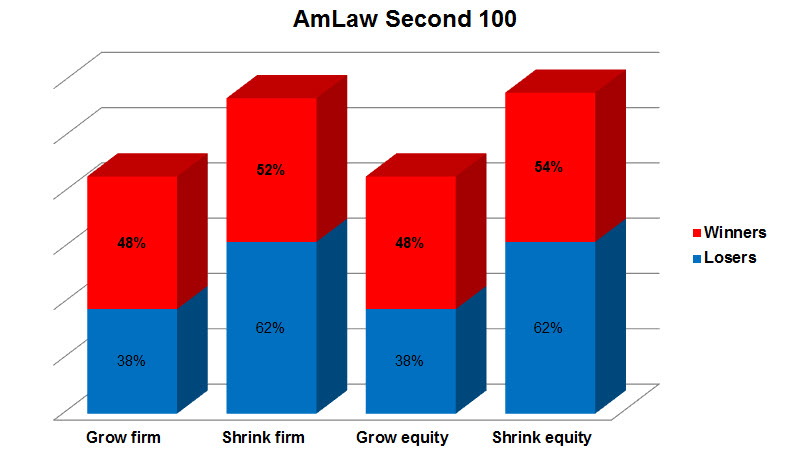Brief thoughts prompted by the release a few days ago of the AmLaw Second Hundred. These are firms ##101—200 in the AmLaw ranking, and by and large they’re regional shops based in secondary metropolitan areas, or small shops in primary cities, or specialists.
First a few headline numbers just to set the stage:
- For these firms overall, topline revenue grow by 2.6% to $19-billion
- RPL was up 2.5% to $626,784
- But PPP was up just 0.7% (less than inflation) to $701,310, even as the number of equity partners shrank slightly (by 30).
And as we’ve come to expect, results showed wider dispersion than ever. Getting the short end of the stick:
- On revenue, 36 firms saw absolute declines, another eight a gain of less than 1%
- 47 shrank in terms of headcount, while nine grew less than 1%
- And 40 showed lower PPP, four were at 0% change, and seven at < 1% growth.
In what I believe is a first—and an innovation worth institutionalizing for the future—AmLaw also broke out the 20 of the Second Hundred firms that would have placed in the First Hundred based on RPL and PPP. They were on the long end of the stick, as it were, with revenue up 4.5%, RPL +4.7%, and PPP +3.0%.
That’s great if you’re one of the Nifty Fifty Twenty, but what about the rest of you? Any lessons to be drawn?
As The American Lawyer says,
There seems to be no shortage of suggestions and advice in the marketplace. Take your pick: Add head count! Cut partners! Stick to your region! Head for parts unknown! Or, maybe just the opposite! How are those well-crafted bromides working out in actual practice?
To answer that question, they did a truly useful analysis (as regular readers know, I use those words sparingly).
They divided the Second Hundred firms for whom they had five-year performance records (87 of the 100) and separated them into two groups, those whose RPL matched or beat inflation (50 firms) and those who fell short (the other 37).
The key buttons managing partners seem to push—rightly or wrongly—are growing or shrinking total headcount and growing or shrinking the ranks of equity partners. (I’m not saying those are the most important buttons to push, I’m saying they’re the buttons most commonly pushed.)
So on those metrics, what do we learn?
Actually, looking at the data, we seem to learn nothing:
- Of the “good” 50 firms:
- 24 increased head count, 26 cut it
- 24 increased equity ranks, 23 cut and three stayed flat
- Of the “bad” 37 firms:
- 14 increased head count, 23 cut it
- 12 increased equity ranks, 23 cut it and two stayed flat.
Graphically, here it is:
This makes it look like a coin toss, supporting “we learn nothing.”
Not so.
We actually learn something critically important: Pushing these buttons does nothing. More rigorously, changing the readings on these dials has no systemic impact. Something else must be afoot that explains out- and under-performance.
The answer, I suspect, has a lot to do with knowing who you are and what clientele you’re targeting and virtually nothing to do with throw-weight.
Yes, I know this used to be easy. Increase headcount and increase revenue; increase equity partner ranks and increase the rain-maker quotient. What could possibly go wrong?
Welcome to a post-“growth is dead” world. It’s time to think new thoughts. I have a few, so let me know if you’d like to chat.
In times of turbulence the biggest danger is to act with yesterday’s logic.
—Peter Drucker



